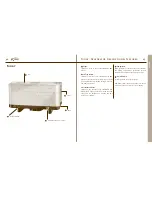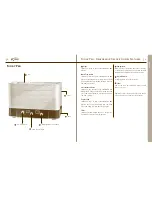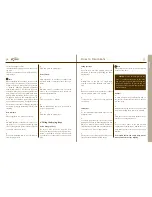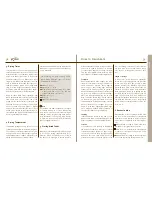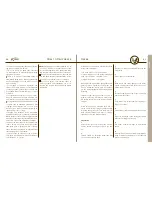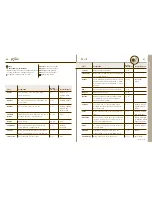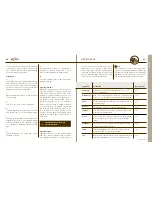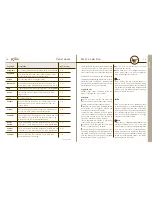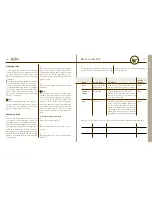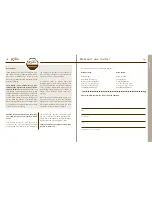
70
71
Vegetable
Preparation
Dry Time (Hrs)
Cucumbers
Peel (skin is bitter when dried). Slice or shred. Salt, if desired.
4 – 10
Eggplants
Trim. Peel. Cut into round slices, julienne strips or cubes.
Blanch / steam. Skin may be dried separately.
4 – 14
Greens
Cut off stems. Blot dry on paper towels.
4 – 10
Mushrooms
Remove woody stems. Wipe with brush or cloth. Do not
wash. Slice or cube. Small mushrooms may be dried whole.
4 – 10
Okra
Trim off stem and tip. Slice pods into pieces or cut lengthwise. 4 – 10
Onions
Cut off stem and root. Remove outer skin cut in slices,
rings or dice.
6 – 12
Peas
Sort. Blanch / steam.
5 – 14
Peppers
Remove stem and seed head. Cut in rings, strips or dice.
Seeds may also be dried. Blanch / steam. For seeds use
leather sheets.
5 – 12
Potatoes
Peel. Remove green lining just under skin. Cut away bruis-
es. Cut into slices, strips or grate. Blanch / steam.
4 – 12
Pumpkins
Cut in half. Scrape away pulp and seeds. Remove rind. Cut
into wedges 2,5 – 7,5 cm wide and then into strips 1,2 cm
wide. Seeds can also be dried. Blanch/steam.
6 – 12
Winter
Squash
Cut in half. Remove seeds and stringy fiber. Peel off rind. Cut
into strips or cubes. Seeds may also be dried. Blanch /steam.
4 – 10
Summer
Squash
Cut in half. Remove seeds and stringy fiber. Peel off rind. Cut
into strips or cubes. Seeds may also be dried. Blanch/steam.
4 – 10
Tomatoes
Remove stem area. Peel, if desired. Cut in slices. Blot
excess moisture before drying.
6 – 12
Meats and Fish
ENGLISH
* Average Dry Time
Vegetables
The KoMo Dehydrator can make dried meat and
jerky. Dried meat refers to meat, poultry, or fish
that has been cooked then dried. Jerky is raw
meat or fish that has been seasoned and dried.
Dried meats are best when made for upcoming
camping and backpacking trips. When reconsti-
tuted, they yield a tasty meat, somewhat like
fresh cooked. Practically any meat can be dried,
but fatty meats are not recommended.
Suggested uses
Snacks, soups, stews, casseroles, pizza top-
pings or rehydrate and use in salads.
Guidelines
Choose lean cuts of meat. The leaner the
meat, the better quality of the dried product.
Chicken breasts are leaner than dark meat.
Cleanliness is critical when working with raw
meats. Make sure all surfaces, utensils and
your hands, are washed thoroughly.
Except for jerky, all meats, fish and poultry
should be cooked before being dried. Braising,
pot roasting or steaming are best, because no
fat is used with these cooking methods.
Never dehydrate raw chicken or poultry be-
cause it could contain salmonella.
Cut meats across the grain into thin strips
about 2,5 cm wide and 0,5 cm thick.
Trim off all fat and connective tissues. For eas-
ier cutting, partially freeze by placing meats on
the bottom of the freezer for about 30 minutes.
Turn and freeze 15 minutes longer. To prepare
fish, filet, then cut into 2,5 cm strips.
Do not store dried meat, fish, or poultry
longer than two months.
Store dried meat in an airtight container, a
sealed plastic bag, or jar with an airtight lid.
Keep in the refrigerator or freezer.
Note
Meats, poultry, and fish generally take 6 – 12
hours to dry. This is a general guideline. Drying
times may vary. Dehydrated meats, poultry and
fish darken in color when dried. Dehydrate until
pieces are dry but will bend without breaking,
with no evidence of moisture.
Jerky
Jerky is the only meat to be placed uncooked
in the dehydrator. Your KoMo Expandable De-
hydrator quickly turns thin strips of seasoned
meat or ground beef strips into a hearty snack.
It is recommended that pork not be dried for
jerky, as the drying temperature is not high
enough to kill harmful bacteria.
Note
Start Jerky at 70 °C (highest setting). After 4 hours
decrease temperature to 60 – 62 °C. Dry until
desired texture is reached. Jerky generally takes
6 – 10 hours to dry. This is a general guideline.
Drying times may vary. Dehydrate until strips
are dry, but can be bent without breaking. Jerky
should be tough (slightly chewy), not brittle,
with no evidence of moisture.




